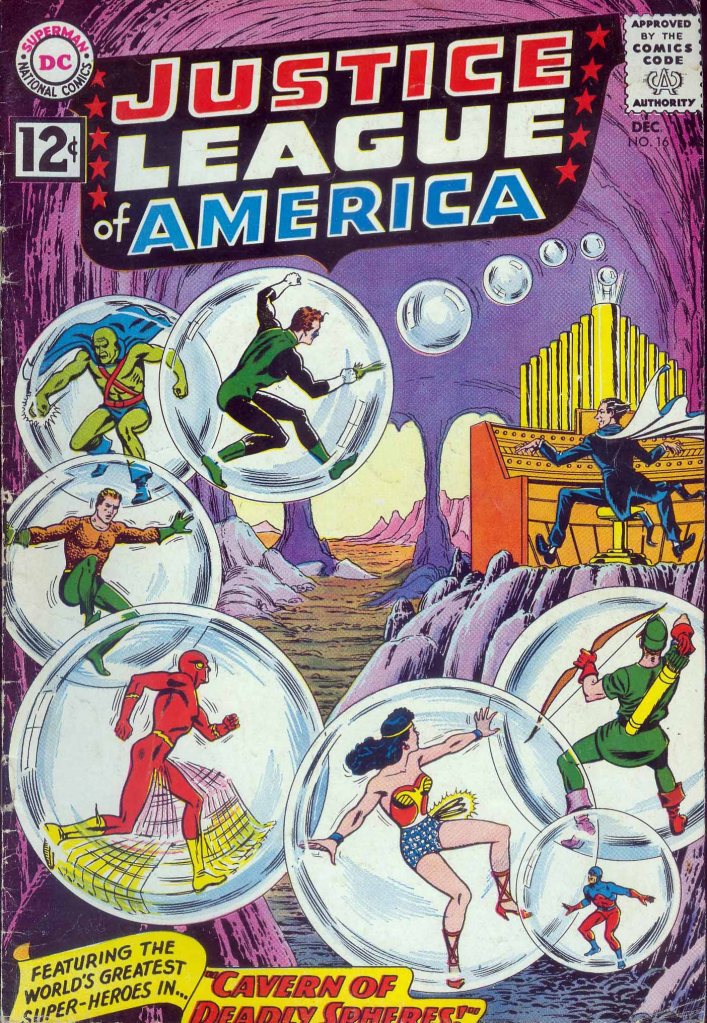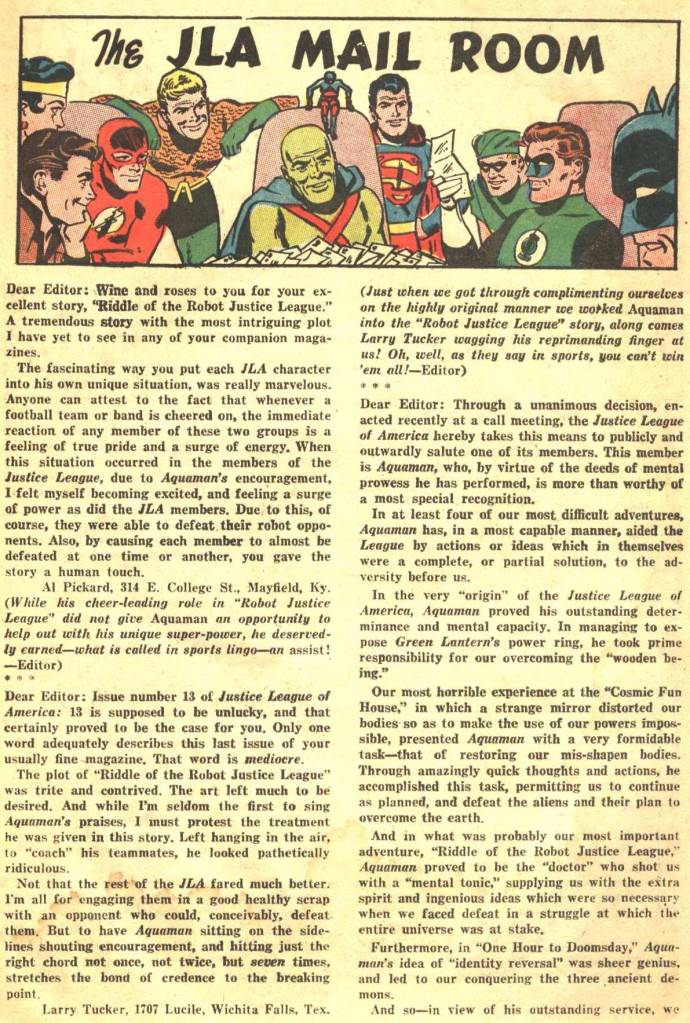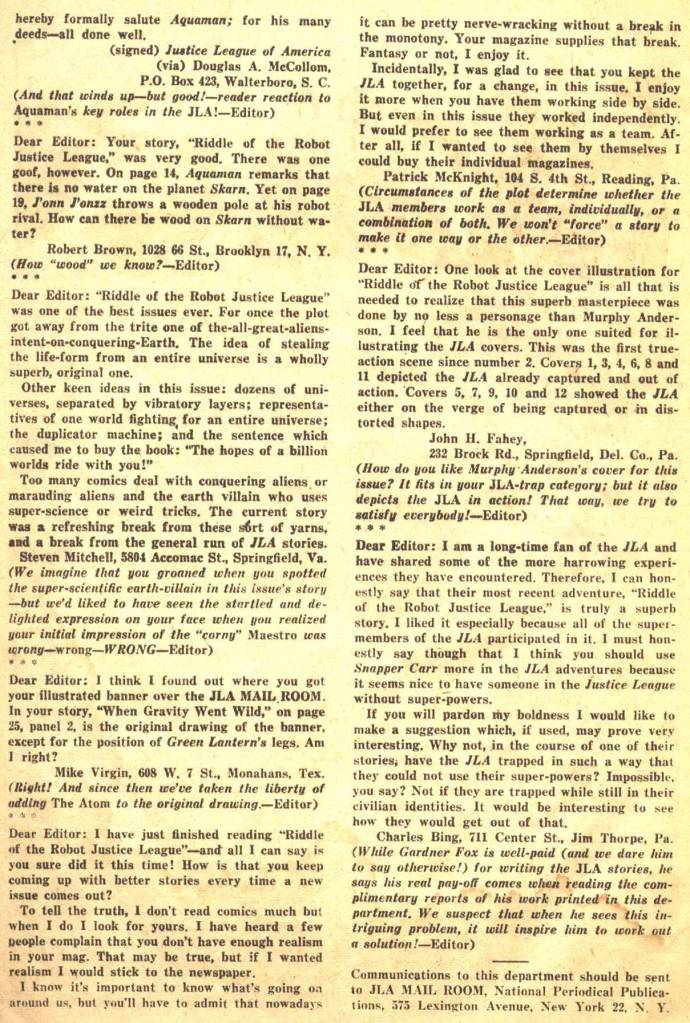
This was another issue of JUSTICE LEAGUE OF AMERICA that I got in my Windfall Comics purchase of 1988, in which I bought a box of around 150 Silver age comics for the princely sum of $50.00. It was one of six sequential issues, #15-20, that were part of the buy. As JUSTICE LEAGUE had been a favorite title since the days of my youth, this was a welcome development. That’s a nice cover by regular cover artist Murphy Anderson. The only thing I might do differently today is to turn some of the JLAers a little bit so that we’re not seeing most of them completely from behind.

This many issues into the series, the regular creative contributors–author Gardner Fox, illustrator Mike Sekowsky and editor Julie Schwartz–had their formula down to a science. So this is an almost textbook JLA adventure for the period, albeit one with a fun twist to it. A few issues earlier, Schwartz had been given permission to regularly feature both Superman and Batman in the series, over the objections of their solo editors Mort Weisinger and Jack Schiff, so the ranks of the League were swelled as never before. But having those ultra-popular characters in evidence gave the whole series a bit more legitimacy. This issue features ten super heroes (assuming you count Snapper Carr in that number), which was a pretty great value for a reader’s 12 cents in 1962.

The story opens with the assorted members of the Justice League heading towards their headquarters for a regular meeting. Along the way, each group of three comes across a crime in progress. Attempting to intercede, they find themselves being forced to dance uncontrollably by the mysterious music created by the criminal behind this crime wave, the Maestro. Having all been stymied in their attempts to prevent the assorted heists, the team reassembles in their Secret Sanctuary where honorary member Snapper Carr waits, so they can compare notes and work out a strategy to track down the Maestro.

A pause here for a lovely house ad composed by demon DC letterer Ira Schnapp advertising the Strange Sports Stories feature then premiering in the pages of BRAVE AND THE BOLD. Strange Sports Stories was a concept near and dear to editor Schwartz’s heart, being a baseball fanatic himself. The idea was tried in both the 1960s and again in the 1970s but failed to attract enough of an audience to become a regular feature, despite some imaginative ideas and visuals.

As the second story chapter opens, the League begins to formulate a plan of attack–while having to allay the concerns of the Atom, who feels especially useless, having not contributed to the earlier struggle in a meaningful way. But the League always stresses teamwork, and his fellow members remind the Atom of all the times in the past he held the key to their victory. Could this be foreshadowing? The team heads out, swiftly tracking down the Maestro’s lair deep within an underground cavern in the mountainside. Before attacking, the heroes take the precaution of plugging their ears so that they will be unable to hear the Maestro’s music and thus be overcome. Having done so, they burst into the Maestro’s sanctum.

But suddenly, the Justice League is once again forced to dance. While unable to resist, the Maestro uses his pipe organ to manifest special bubbles to encase and entrap each of the heroes. he reveals to them that his music was a feint, a bit of misdirection. He actually had been using a cosmi-radio beam to override the muscular controls in their brains, making them dance. But he disguised it as being caused by the music so that he could gain the upper hand over the team when they came to counter-attack. With the League unable to resist or fight back, the Maestro collapses the cavern atop them, burying them all alive and eliminating them permanently!


Next up was the double page JLA Mail Room letters page, filled with correspondents who had clearly been following Schwartz’s titles and who felt a kinship with them, even though the page was still anonymously put together. Schwartz is chummier on this page than most of the others we’ve seen–it’s possible that the specific fandom for Justice League brought this quality out in him more. JLA fandom was a huge part of the center of comic book fan activity in the early Silver Age.

Back in the third chapter, and now we come to the twist. And it’s a bit of a cheat, to be honest. It turns out that the adventure that we had ben reading never happened at all. It was, instead, a fan comic sent to the League by super-fan Jerry Thomas. This is meaningful in that the character in question, and this story in general, was all a tip of the hat to two of the book’s biggest fans, Dr. Jerry Bails (often called the godfather of comic book fandom) and Roy Thomas (who had not yet become a comic book writer and editor.) The fictitious Jerry Thomas had come up with a made-up villain and situation that the Justice League couldn’t overcome. Concerned that some genuine villain might learn of the proposed plan, he sent it to the League in the hopes that they’d be able to find a way out of the death trap and ensure that they might be able to cope with any such real world parallel.

And they do, of course–thanks to (you guessed it!) the Atom! Early on in the story, there’s a point where the Atom travels using his typical trick of riding the phone lines. Emerging from the phone, he was immediately compelled to dance, even though he would have been too small to have heard the music. With that clue, the Leagues realize that they would have been able to deduce earlier that the Maestro’s weapon wasn’t the music at all, and to take the necessary counter-measures. They imagine a course of action, which is helpfully visualized for us by Sekowsky, in which Superman covers himself in lead so as to be immune to any kryptonite in the Maestro’s secret weapon, then bursting free in time to save the rest of the team and bring the Maestro to justice. Good thing Mort Weisinger let him hang out with the group, hey? In the end, Snapper Carr announces that he’s going to draw their resolution up and send it back to Jerry Thomas as a thank you. The real Dr. Jerry Bails was the recipient of assorted original artwork from editor schwartz during the period in which he was giving it out as a prize to letter writers, so this is also a bit of self-reference.

And at the very back of the book we find another Ira Schnapp house ad, this one touting the wonders of the latest two SUPERMAN and BATMAN Annuals. These fat reprint collections were a regular wonder of the era, and remembered well by the readers who snapped them up.

“A few issues earlier, Schwartz had been given permission to regularly feature both Superman and Batman in the series, over the objections of their solo editors Mort Weisinger and Jack Schiff, so the ranks of the League were swelled as never before”. Ok, but why not put them also on the cover?
LikeLike
That tended to be a sop to Mort and Jack, at least for a while. A bit later, they’d start showing up on covers more regularly.
LikeLike
When I christened Dr Jerry as “the Father of Modern Comics Fandom” in ’75 or ’76, he said he was surprised at the title. I have to wonder if he said that because I tacked on the word “modern” at the last minute? Surely someone referenced him as “the Father” in 1963 during the purple days of ditto’d issues of the Comics Reader? Can anyone remember if and when?
LikeLike
Since you call out Ira Schnapp’s work in the house ads, let’s note that the letterer for the story itself is quite obviously Gaspar Saladino. The dry-brush work on “deadly”, the shapes of the S letters and the question marks: these are clear signs.
(It helps here that I follow Todd Klein’s blog: he has been exhaustively cataloging both men’s work.)
LikeLike